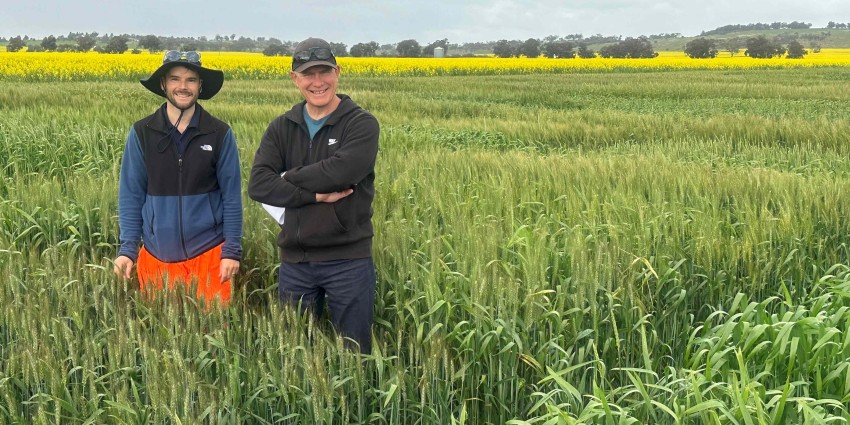Australia
September 25, 2024
A decade of research to protect Western Australian crops from the impact of frost was shared with scientists and leaders in the global grains industry at the 3rd International Wheat Congress in Perth today.

DPIRD research scientist Dr Brenton Leske (left) and CSIRO principal research scientist Dr Richard James in wheat plot at the department’s Dale Research Station.
The congress was organised by the Centre for Crop & Food Innovation and the WA State Agricultural Biotechnology Centre – a collaboration between Murdoch University, The University of WA and the State Government.
The event attracted more than 900 researchers, policy makers and scientists from 52 countries.
Frost incidences and severity have increased over the past 20 years, which can cost Australian growers up to $410 million.
Department of Primary Industries and Regional Development (DPIRD) research scientist Brenton Leske told the gathering a suitable long term site to screen for frost was essential to help farmers manage the risk to crops.
Dr Leske said the department’s Dale Frost Research site, near Beverley, had been pivotal to the success of a range of frost research projects and initiatives.
“Establishing a long term trial site to characterise large crop populations to search for reproductive frost tolerance in wheat and other grain crops was an upmost priority,” he said.
“Dale was established in 2016 and grew from humble beginnings to a fully serviced 40 hectare trial site, with irrigation to create a reliable field phenotyping environment.
“Since then, more than 1200 wheat germplasm have been screened for frost tolerance and the site has hosted many and varied trials to better understand frost and develop strategies that help farmers reduce its impact on crops.”
The Dale site was selected for access to irrigation water, its uniform soil type, and flat area for trials, but surrounded by undulating topography to enhance frost occurrences to produce discriminate levels of damage.
The location’s accessibility to Beverley and Perth was also beneficial to research activities throughout the field trials.
The site is managed to ensure uniform frost impacts with bulk crops, sown early around the trial area to lead to early canopy closure and remain until after the frost window, while managing the rotational impacts of the site.
Dr Leske said the Dale frost nursery had been a reliable site that had hosted a suite of agronomic frost research that would aid crop productivity and profitability.
“Research outcomes include findings that high stubble loads increase the severity and duration of frost events, through the presence of ice nucleating bacteria,” he said.
“Trials have also shown that wheat is the most susceptible to frost, followed by barley and then oats."
Current research includes screening wheat for plant secondary compounds in leaf tissue that might shed some light on frost susceptibility and evaluating wheat traits for their potential to improve frost tolerance.
“Frost has always been a challenging environmental stress to study, as the severity and duration cannot be easily manipulated to give discriminating levels of damage between treatments,” Dr Leske said.
“Pre-breeding research at Dale is imperative to help plant breeders select and breed new varieties more tolerant to frost events.
“With climate change likely to increase environmental stresses on crops, including frost, research like that at Dale will become even more important to help growers manage and adapt to this risk.”
For more information and details about the 3rd International Wheat Congress visit www.iwc2024.com(link is external).